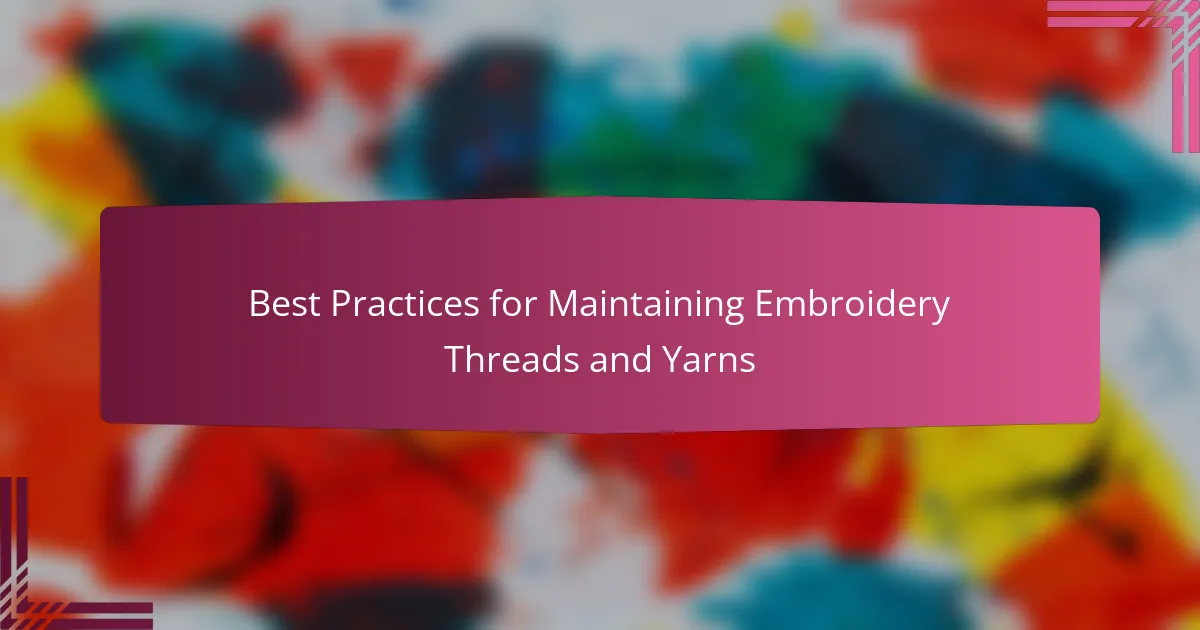
What are the best practices for maintaining embroidery threads and yarns?
Store embroidery threads and yarns in a cool, dry place. High humidity can lead to mold and deterioration. Use transparent containers to keep threads organized and visible. Avoid direct sunlight, which can fade colors. Regularly check for tangles and knots to maintain usability. Keep threads away from pets to prevent damage. Use acid-free tissue paper to wrap delicate threads for added protection. Label containers for easy identification of colors and types.
How can proper storage extend the life of embroidery threads and yarns?
Proper storage can significantly extend the life of embroidery threads and yarns by preventing damage and degradation. Storing threads in a cool, dry place prevents exposure to moisture, which can cause mildew and weaken fibers. Keeping threads away from direct sunlight protects them from fading and color loss. Using containers that are airtight can help keep dust and pests away, preserving the quality of the materials. Organizing threads by color or type in a manner that prevents tangling reduces wear and tear during handling. Additionally, maintaining a consistent temperature prevents the expansion and contraction of fibers, which can lead to fraying. These practices collectively contribute to the longevity and usability of embroidery threads and yarns.
What types of storage solutions are recommended for embroidery threads?
Clear storage containers are recommended for embroidery threads. These containers protect threads from dust and light exposure. Thread racks are also effective for easy access and organization. Spools can be displayed on racks to prevent tangling. Drawer organizers help separate different thread colors and types. Additionally, zippered bags are useful for travel or temporary storage. Proper labeling ensures quick identification of thread types. Each of these methods contributes to preserving thread quality and longevity.
How does temperature and humidity affect thread and yarn longevity?
Temperature and humidity significantly affect thread and yarn longevity. High temperatures can cause fibers to weaken and degrade over time. Excessive humidity can lead to mold and mildew growth on threads and yarns. These conditions can also cause threads to become brittle or lose their elasticity. Studies show that maintaining a stable environment with moderate temperature and humidity extends the lifespan of textile materials. For example, a relative humidity level between 40% and 60% is ideal for preserving fibers. Keeping threads and yarns in a cool, dry place prevents deterioration and maintains quality.
What cleaning methods are safe for embroidery threads and yarns?
Gentle hand washing is a safe cleaning method for embroidery threads and yarns. Use lukewarm water and a mild detergent specifically designed for delicate fabrics. Avoid harsh chemicals and bleach, as they can damage the fibers. Rinse thoroughly to remove any detergent residue. Air drying is recommended to prevent shrinkage or distortion. For stubborn stains, spot cleaning with a damp cloth is effective. Always test cleaning methods on a small sample first to ensure colorfastness. These methods help maintain the integrity and appearance of embroidery threads and yarns.
How can you effectively remove dirt and dust from threads?
To effectively remove dirt and dust from threads, use a soft brush or lint roller. A soft brush can gently sweep away particles without damaging the thread fibers. Lint rollers are also effective, providing a sticky surface that captures dirt and dust. For deeper cleaning, consider using a damp cloth to wipe the threads carefully. Avoid soaking the threads as excess moisture can weaken them. Regular maintenance helps preserve the quality of embroidery threads and yarns. Keeping threads in a clean environment reduces the accumulation of dirt and dust over time.
What precautions should be taken when washing threads and yarns?
When washing threads and yarns, it is essential to use cold water to prevent color bleeding. Hot water can cause dyes to run, damaging the threads. Use a gentle detergent specifically designed for delicate fabrics. Harsh chemicals can weaken the fibers over time. Avoid using bleach, as it can lead to discoloration and degradation. It is advisable to hand wash threads and yarns instead of machine washing. The agitation in machines can cause tangling and fraying. If machine washing is necessary, use a mesh laundry bag to protect them. Additionally, air drying is preferred over using a dryer. High heat can shrink or warp the fibers. These precautions help maintain the quality and longevity of threads and yarns.
Why is it important to organize embroidery threads and yarns?
Organizing embroidery threads and yarns is important for efficiency and creativity. Proper organization prevents tangling and damage to the materials. It allows for easy access to colors and types needed for projects. This saves time during the crafting process. Organized threads also help in maintaining inventory awareness. Crafters can quickly identify what is available and what needs replenishing. Additionally, a well-organized workspace promotes a more enjoyable crafting experience. Studies show that organized environments can enhance focus and productivity.
What are the most effective organizational methods for threads?
The most effective organizational methods for threads include using thread racks, labeled containers, and color-coded systems. Thread racks allow for easy visibility and access to spools. Labeled containers help in identifying thread types and colors quickly. Color-coded systems can enhance organization by grouping similar threads together. Additionally, drawer organizers can keep threads neatly stored and prevent tangling. Regular inventory checks ensure that supplies are up to date. These methods improve efficiency and reduce time spent searching for specific threads.
How does organization impact project efficiency?
Organization significantly enhances project efficiency by streamlining processes and reducing time wastage. A well-organized workspace allows for quick access to materials, which minimizes delays. Studies show that organized teams can complete tasks up to 25% faster than disorganized teams. Clear categorization of tools and supplies reduces the time spent searching for items. Additionally, organization fosters better communication among team members. This leads to fewer misunderstandings and errors. Overall, effective organization is crucial for maximizing productivity in project management.
How can you prevent tangling and damage to threads and yarns?
To prevent tangling and damage to threads and yarns, store them properly. Use clear containers or organizers to keep threads separated. Avoid exposing threads to direct sunlight, as this can weaken fibers. Always rewind threads onto spools after use to maintain their shape. When working, ensure that threads are not pulled tightly, as this can cause knots. Regularly check for tangles and gently detangle them to avoid breakage. Keeping threads away from sharp objects will also minimize damage. These practices help maintain the integrity and usability of threads and yarns.
What techniques can be used to avoid tangling during use?
To avoid tangling during use, keep threads and yarns organized. Use thread organizers such as spools or bobbins to prevent knots. Always unwind the thread gently before starting a project. Avoid pulling the thread too tightly while working, as this can cause tangling. Regularly check for twists in the thread and untangle them immediately. Store threads in a cool, dry place to prevent friction. Using a thread conditioner can also help reduce tangling. These techniques are effective in maintaining smooth usage and preventing frustration during embroidery or yarn work.
How can you repair damaged threads and yarns effectively?
To repair damaged threads and yarns effectively, first identify the type of damage. For frayed threads, trim the damaged section with sharp scissors. Then, re-thread the needle with a new piece of thread, matching the color and type. For broken yarns, tie a secure knot to join the ends. Ensure the knot is tight and blends with the surrounding stitches. For larger repairs, consider using a patch or darning technique. This involves weaving new yarn into the damaged area to reinforce it. Following these methods helps restore the integrity of the threads and yarns. Regular maintenance prevents further damage and prolongs the life of your embroidery projects.
What are common mistakes to avoid in maintaining embroidery threads and yarns?
Common mistakes to avoid in maintaining embroidery threads and yarns include improper storage, exposure to sunlight, and neglecting to clean them regularly. Storing threads in humid environments can lead to mold growth. Sunlight can cause colors to fade over time. Not using thread organizers can result in tangling and damage. Failing to replace old or frayed threads can affect the quality of embroidery. Ignoring the manufacturer’s care instructions can lead to deterioration. Lastly, using incorrect thread tension can cause uneven stitching. These practices can significantly impact the longevity and quality of embroidery materials.
What practices can lead to premature wear of threads?
Improper storage and exposure to light can lead to premature wear of threads. Storing threads in direct sunlight can cause fading and degradation. Additionally, humidity can weaken the fibers, making them more susceptible to breakage. Using incorrect tension settings during embroidery can also strain threads, leading to fraying. Overuse of threads without proper maintenance can result in wear and tear. Frequent washing and exposure to harsh detergents can further diminish thread quality. Regularly checking for knots and tangles can prevent unnecessary stress on the threads.
How can improper handling affect thread quality?
Improper handling can significantly degrade thread quality. Physical damage occurs when threads are twisted, pulled, or snagged during handling. This can lead to fraying and breakage. Environmental factors like moisture and sunlight can also negatively impact threads if not stored properly. Threads exposed to high humidity may absorb moisture, causing them to weaken. Additionally, improper storage can lead to tangling and kinking. These issues result in inconsistent tension and stitching problems during embroidery. Thus, maintaining proper handling practices is essential for preserving the integrity of embroidery threads.
What tips can enhance the longevity of embroidery threads and yarns?
To enhance the longevity of embroidery threads and yarns, proper storage is essential. Store threads in a cool, dry place away from direct sunlight. Exposure to light can fade colors and weaken fibers. Use clear containers to keep threads organized and visible. This prevents tangling and damage. Avoid storing threads in humid areas, as moisture can lead to mold and deterioration. Regularly check for fraying or damage before use. Replace any compromised threads to maintain quality in your projects. Following these tips can significantly extend the life of your embroidery materials.
How often should you check and maintain your thread collection?
You should check and maintain your thread collection at least once a month. Regular inspections help identify any damage or deterioration. Look for fraying, discoloration, or tangling. Proper maintenance includes organizing threads by type and color. Store threads in a cool, dry place to prevent moisture damage. Keeping threads in their original packaging can also protect them. Regular checks ensure your collection remains in optimal condition for use.
What are the best practices for using and handling threads during projects?
Use threads carefully to ensure quality and longevity in embroidery projects. Always store threads in a cool, dry place to prevent damage. Handle threads gently to avoid fraying or tangling. Use appropriate tension when sewing to maintain even stitches. Keep threads organized by color and type to streamline the embroidery process. Regularly check for any signs of wear or damage before use. Clean the sewing machine regularly to avoid thread breakage. Following these practices can enhance the overall quality of embroidery work.
The main entity of this article is embroidery threads and yarns, focusing on best practices for their maintenance. Key topics include proper storage techniques to prevent damage and degradation, effective cleaning methods to maintain thread integrity, and organizational strategies to enhance project efficiency. The article emphasizes the impact of temperature and humidity on thread longevity, as well as common mistakes to avoid that can lead to premature wear. Additionally, it provides tips for using and handling threads during projects to ensure quality outcomes.
